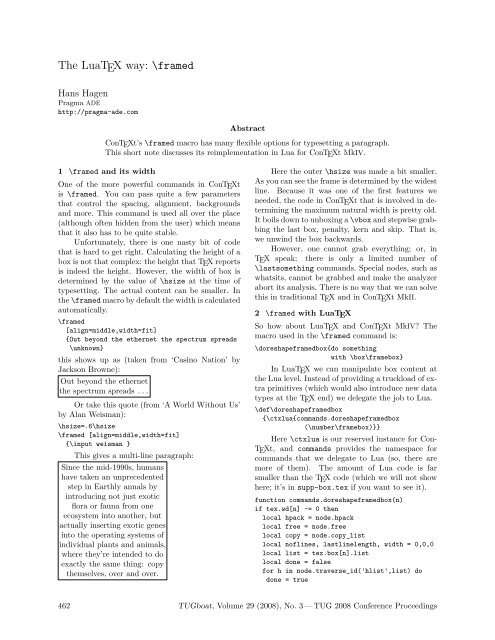The Communications of the TEX Users Group Volume 29 ... - TUG
The Communications of the TEX Users Group Volume 29 ... - TUG
The Communications of the TEX Users Group Volume 29 ... - TUG
Create successful ePaper yourself
Turn your PDF publications into a flip-book with our unique Google optimized e-Paper software.
<strong>The</strong> Lua<strong>TEX</strong> way: \framed<br />
Hans Hagen<br />
Pragma ADE<br />
http://pragma-ade.com<br />
Abstract<br />
Con<strong>TEX</strong>t�s \framed macro has many flexible options for typesetting a paragraph.<br />
This short note discusses its reimplementation in Lua for Con<strong>TEX</strong>t MkIV.<br />
1 \framed and its width<br />
One <strong>of</strong> <strong>the</strong> more powerful commands in Con<strong>TEX</strong>t<br />
is \framed. You can pass quite a few parameters<br />
that control <strong>the</strong> spacing, alignment, backgrounds<br />
and more. This command is used all over <strong>the</strong> place<br />
(although <strong>of</strong>ten hidden from <strong>the</strong> user) which means<br />
that it also has to be quite stable.<br />
Unfortunately, <strong>the</strong>re is one nasty bit <strong>of</strong> code<br />
that is hard to get right. Calculating <strong>the</strong> height <strong>of</strong> a<br />
box is not that complex: <strong>the</strong> height that <strong>TEX</strong> reports<br />
is indeed <strong>the</strong> height. However, <strong>the</strong> width <strong>of</strong> box is<br />
determined by <strong>the</strong> value <strong>of</strong> \hsize at <strong>the</strong> time <strong>of</strong><br />
typesetting. <strong>The</strong> actual content can be smaller. In<br />
<strong>the</strong> \framed macro by default <strong>the</strong> width is calculated<br />
automatically.<br />
\framed<br />
[align=middle,width=fit]<br />
{Out beyond <strong>the</strong> e<strong>the</strong>rnet <strong>the</strong> spectrum spreads<br />
\unknown}<br />
this shows up as (taken from �Casino Nation� by<br />
Jackson Browne):<br />
Out beyond <strong>the</strong> e<strong>the</strong>rnet<br />
<strong>the</strong> spectrum spreads . . .<br />
Or take this quote (from �A World Without Us�<br />
by Alan Weisman):<br />
\hsize=.6\hsize<br />
\framed [align=middle,width=fit]<br />
{\input weisman }<br />
This gives a multi-line paragraph:<br />
Since <strong>the</strong> mid-1990s, humans<br />
have taken an unprecedented<br />
step in Earthly annals by<br />
introducing not just exotic<br />
flora or fauna from one<br />
ecosystem into ano<strong>the</strong>r, but<br />
actually inserting exotic genes<br />
into <strong>the</strong> operating systems <strong>of</strong><br />
individual plants and animals,<br />
where <strong>the</strong>y�re intended to do<br />
exactly <strong>the</strong> same thing: copy<br />
<strong>the</strong>mselves, over and over.<br />
Here <strong>the</strong> outer \hsize was made a bit smaller.<br />
As you can see <strong>the</strong> frame is determined by <strong>the</strong> widest<br />
line. Because it was one <strong>of</strong> <strong>the</strong> first features we<br />
needed, <strong>the</strong> code in Con<strong>TEX</strong>t that is involved in determining<br />
<strong>the</strong> maximum natural width is pretty old.<br />
It boils down to unboxing a \vbox and stepwise grabbing<br />
<strong>the</strong> last box, penalty, kern and skip. That is,<br />
we unwind <strong>the</strong> box backwards.<br />
However, one cannot grab everything; or, in<br />
<strong>TEX</strong> speak: <strong>the</strong>re is only a limited number <strong>of</strong><br />
\lastsomething commands. Special nodes, such as<br />
whatsits, cannot be grabbed and make <strong>the</strong> analyzer<br />
abort its analysis. <strong>The</strong>re is no way that we can solve<br />
this in traditional <strong>TEX</strong> and in Con<strong>TEX</strong>t MkII.<br />
2 \framed with Lua<strong>TEX</strong><br />
So how about Lua<strong>TEX</strong> and Con<strong>TEX</strong>t MkIV? <strong>The</strong><br />
macro used in <strong>the</strong> \framed command is:<br />
\doreshapeframedbox{do something<br />
with \box\framebox}<br />
In Lua<strong>TEX</strong> we can manipulate box content at<br />
<strong>the</strong> Lua level. Instead <strong>of</strong> providing a truckload <strong>of</strong> extra<br />
primitives (which would also introduce new data<br />
types at <strong>the</strong> <strong>TEX</strong> end) we delegate <strong>the</strong> job to Lua.<br />
\def\doreshapeframedbox<br />
{\ctxlua{commands.doreshapeframedbox<br />
(\number\framebox)}}<br />
Here \ctxlua is our reserved instance for Con-<br />
<strong>TEX</strong>t, and commands provides <strong>the</strong> namespace for<br />
commands that we delegate to Lua (so, <strong>the</strong>re are<br />
more <strong>of</strong> <strong>the</strong>m). <strong>The</strong> amount <strong>of</strong> Lua code is far<br />
smaller than <strong>the</strong> <strong>TEX</strong> code (which we will not show<br />
here; it�s in supp-box.tex if you want to see it).<br />
function commands.doreshapeframedbox(n)<br />
if tex.wd[n] ~= 0 <strong>the</strong>n<br />
local hpack = node.hpack<br />
local free = node.free<br />
local copy = node.copy_list<br />
local n<strong>of</strong>lines, lastlinelength, width = 0,0,0<br />
local list = tex.box[n].list<br />
local done = false<br />
for h in node.traverse_id('hlist',list) do<br />
done = true<br />
462 <strong>TUG</strong>boat, <strong>Volume</strong> <strong>29</strong> (2008), No. 3 � <strong>TUG</strong> 2008 Conference Proceedings

















